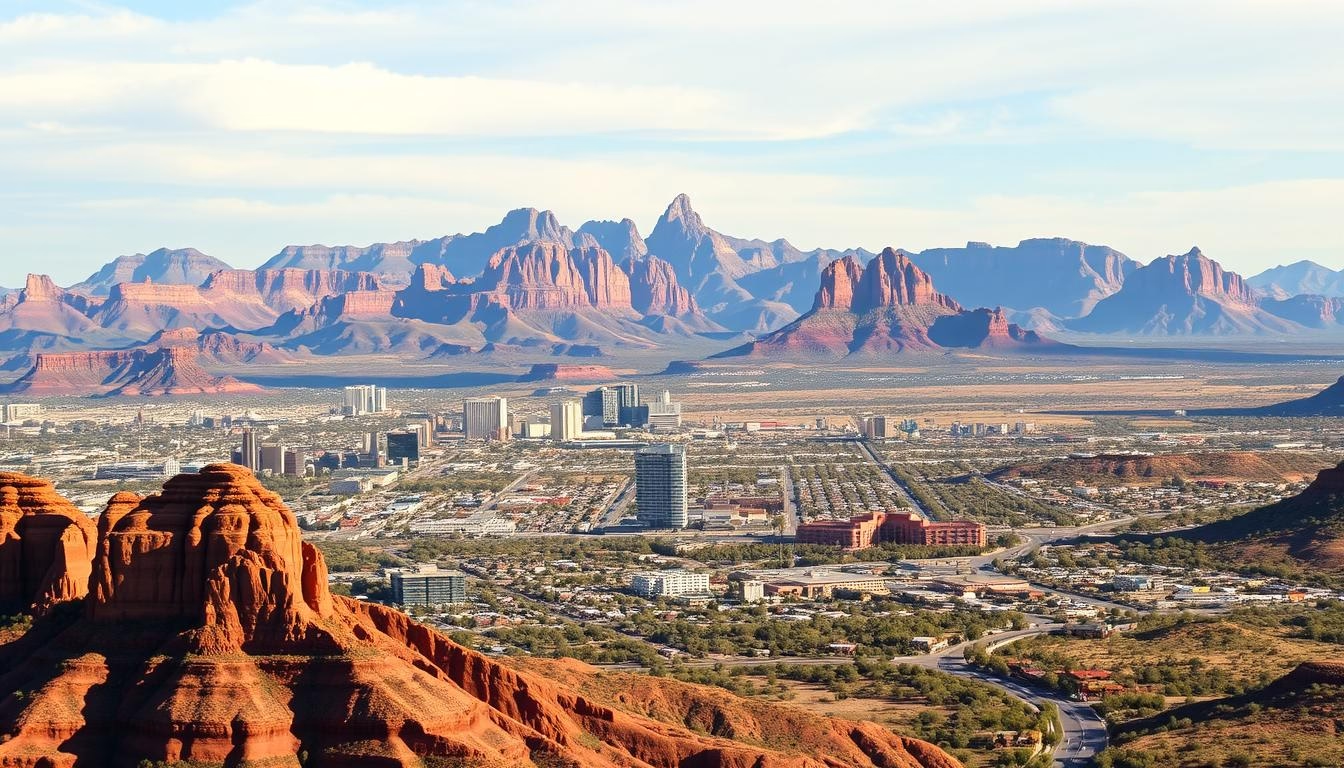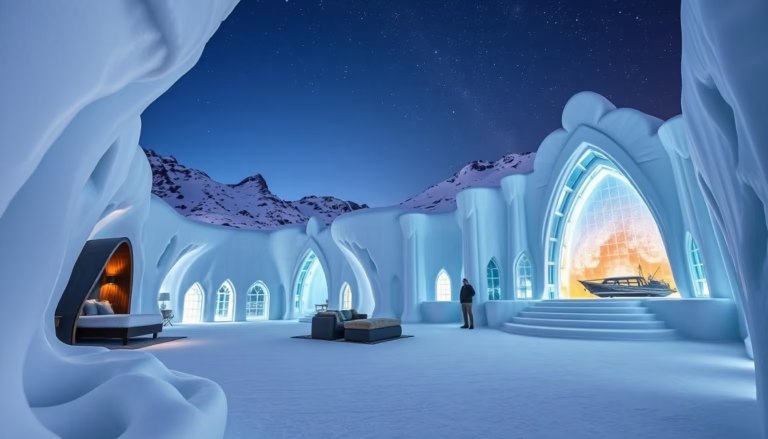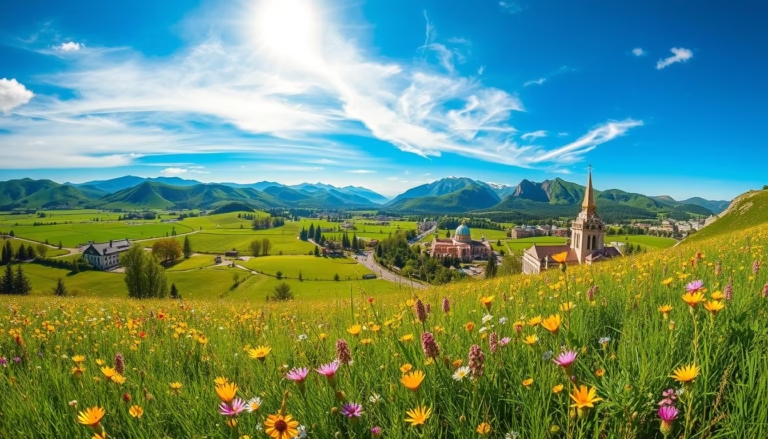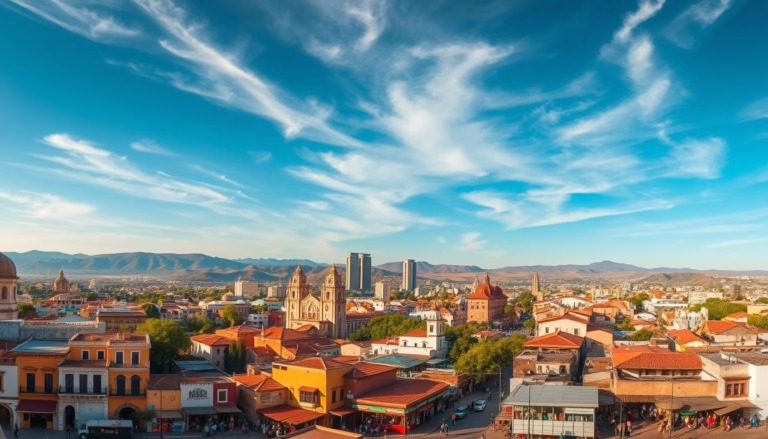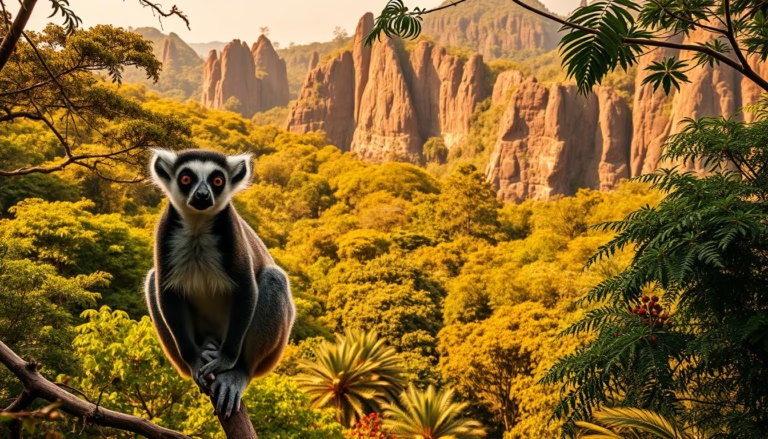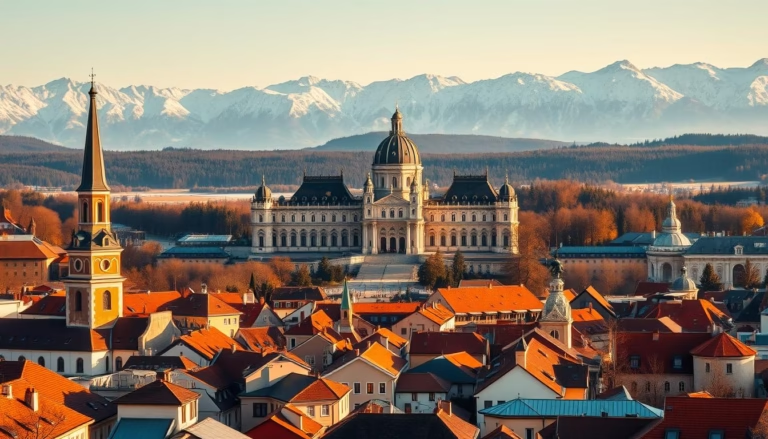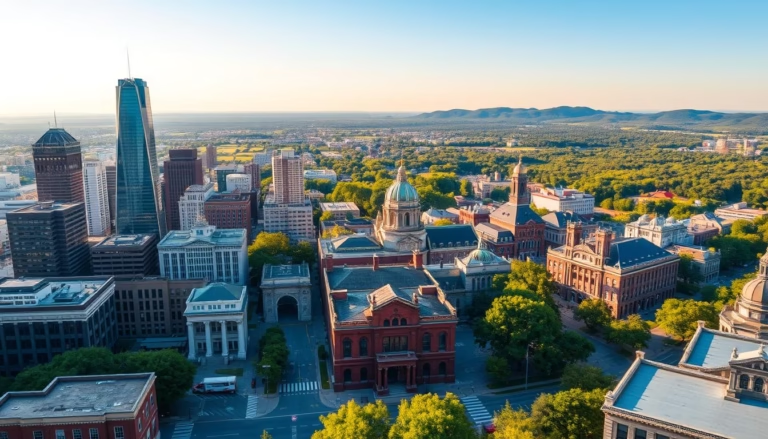Best Cities to Visit in Arizona: Top Destinations
Did you know Arizona welcomes over 46 million visitors annually? This sun-soaked state packs a lot more than desert landscapes — it’s a mosaic of vibrant urban hubs, rugged mountain escapes, and historic towns steeped in Wild West lore.
Many travelers kick off their journey in Phoenix, Tucson, or Flagstaff. These hubs blend modern energy with easy access to natural wonders. Phoenix dazzles with rooftop bars and desert trails. Tucson charms with Spanish colonial roots. Flagstaff serves as a snowy gateway to the Grand Canyon.
No matter your style, Arizona’s cities deliver. Urban explorers find art districts and farm-to-table dining. Adventurers hike red-rock canyons by day and stargaze by night. History buffs wander dusty ghost towns and ancient cliff dwellings. Every place tells a story.
With major airports and year-round sunshine, planning your trip is a breeze. Whether you crave weekend getaways or extended road trips, there’s never a bad time to explore. Ready to uncover Arizona’s hidden gems?
Key Takeaways
- Start in Phoenix, Tucson, or Flagstaff for easy access to diverse experiences
- Mix urban culture with outdoor adventures in a single trip
- Discover Wild West history through preserved towns and landmarks
- Major airports and highways simplify travel logistics
- Enjoy outdoor activities year-round thanks to Arizona’s climate
Introduction to Arizona’s Unforgettable Destinations
Arizona’s terrain feels like flipping through a geography textbook – except every page comes alive. Where else can you hike through cactus-studded valleys at dawn and ski pine-covered slopes by afternoon? This southwestern state packs more surprises than a desert thunderstorm.
The three national parks here – Grand Canyon, Saguaro, and Petrified Forest – reveal nature’s artistic range. Crimson cliffs tower over forests of giant saguaros, while fossilized trees glitter like rainbow quartz. Ancient petroglyphs whisper stories from civilizations past, creating bridges between eras.
Modern amenities blend seamlessly with wild spaces. After exploring slot canyons, you might sip craft cocktails at a James Beard-nominated restaurant. The best places to explore combine rugged trails with cozy wine bars, proving adventure and comfort aren’t mutually exclusive.
What truly sets Arizona apart? Its energy. The desert light paints landscapes in surreal hues, while vortex sites in Sedona hum with mystical vibes. Whether you’re chasing adrenaline or inner peace, the land delivers. Pack your boots and binoculars – unforgettable experiences wait around every mesa.
Exploring the “best cities to visit in arizona”: A Comprehensive Guide
Arizona’s weather plays tricks on newcomers – snow dusts pine forests while cacti bake under relentless sun just hours away. This state’s unique geography creates four distinct climate zones, making trip planning essential. Five neighboring states and Mexico border the region, offering diverse road trip routes through red-rock deserts and high-country trails.
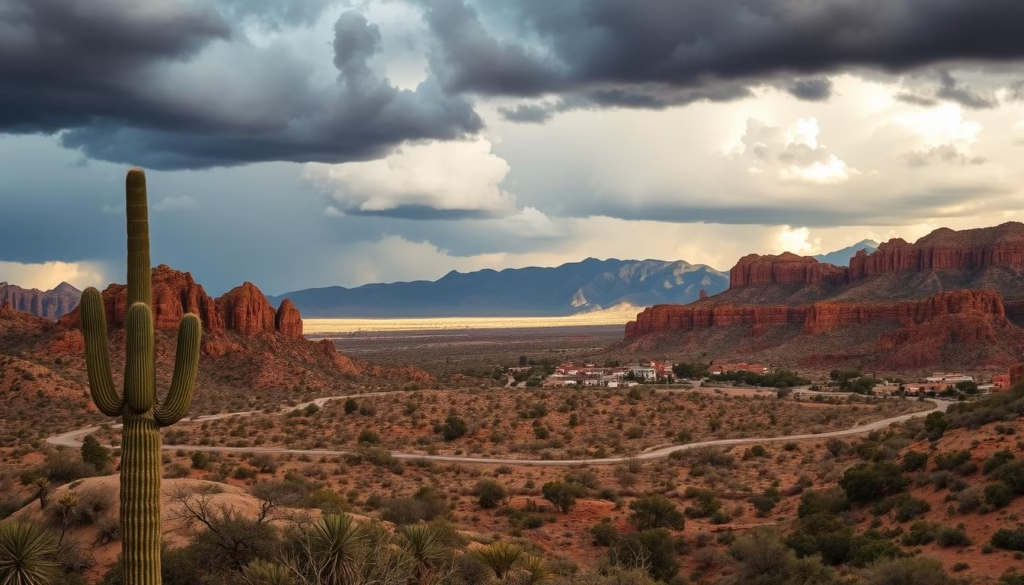
Summer temperatures often soar above 100°F in low-elevation areas, but mountain towns like Flagstaff stay cool. Winter flips the script – frosty mornings in the north contrast with mild days near Tucson. Monsoon season (June-September) brings dramatic thunderstorms – pack rain gear and avoid slot canyons during alerts.
| Region | Best Season | Top Activities |
|---|---|---|
| Desert Parks | Oct-Apr | Hiking, stargazing |
| Mountain Towns | Jun-Sep | Wildflower trails, festivals |
| Border Areas | Year-round | Cultural tours, cuisine |
Three pro tips elevate any Arizona adventure:
1) Carry 2x water in summer
2) Check trail closures after storms
3) Use UV-blocking clothing – the high-altitude sun burns faster here. With 24 state parks and 3 national parks, there’s always new places to explore, from saguaro forests to meteor craters.
Road-trippers love Highway 89A’s twists through oak groves and historic mining towns. For urban escapes, Phoenix’s museums and Tucson’s food scene deliver air-conditioned relief when desert heat peaks. Remember – elevation changes mean temperature swings. Pack layers!
Phoenix: The Desert Metropolis and Cultural Hub
In the heart of the Sonoran Desert, Phoenix blends modernity with natural beauty. This sprawling metropolitan area combines Scottsdale’s luxury resorts, Tempe’s college-town energy, and Glendale’s sports culture into one vibrant hub. Saguaros stand sentry along urban hiking trails, creating a striking contrast between wild landscapes and cosmopolitan comforts.
Urban Attractions and Modern Conveniences
Downtown dazzles with rooftop pools overlooking camelback mountain silhouettes. The Roosevelt Row arts district bursts with murals and indie galleries, while heritage square preserves 19th-century adobe architecture. Foodies rejoice at James Beard-winning restaurants serving chile-colorado tacos and mesquite-grilled specialties.
Gateway to Grand Canyon Trips
Sky Harbor International Airport makes Phoenix the perfect launchpad for Grand Canyon adventures. Day trips to the South Rim take 3.5 hours by car, while helicopter tours reveal the canyon’s vast scale in under two hours. Many guided excursions include stops at Sedona’s red rocks or ancient Native American ruins along the way.
After exploring the Grand Canyon, return to city comforts – craft breweries, open-air shopping plazas, and sunset hot-air balloon rides over the desert. Phoenix proves urban excitement and wild spaces coexist beautifully in Arizona’s sunniest playground.
Tucson: Reliving Old Pueblo History and Culinary Delights
Tucson’s streets hum with stories older than Arizona itself. Adobe walls whisper tales of Spanish missionaries, while modern eateries sizzle with UNESCO-recognized flavors. This desert oasis balances centuries-old traditions with bold Southwestern creativity.
Rich Heritage and Architectural Charms
Stroll through Barrio Viejo’s sunbaked lanes, where 19th-century buildings showcase terra-cotta tiles and hand-carved wooden doors. Mission San Xavier del Bac’s white towers rise like a desert mirage, their sandstone carvings glowing at sunset. Don’t miss the Presidio Museum – its exhibits unpack 4,000 years of regional history.
Vibrant Dining and Nightlife Experiences
Food trucks serve birria tacos beside James Beard-winning kitchens plating chile-rubbed quail. Fourth Avenue buzzes nightly with margarita flights and live mariachi bands. For craft cocktails, head to downtown’s speakeasies where mixologists use local prickly pear syrup.
| Daytime Activities | Nighttime Items | Cultural Must-Sees |
|---|---|---|
| Saguaro National Park hikes | Sonoran hot dogs | Tumamoc Hill petroglyphs |
| Desert Botanical Garden tours | Mezcal tastings | DeGrazia art gallery |
| Historic ranch tours | Mariachi concerts | All Souls Procession exhibits |
Three neighborhoods define Tucson’s culture today: the artsy Mercado District, university-fueled Main Gate Square, and the Rillito River’s vintage markets. Whether exploring ancient trails or dancing under starlit skies, this city feeds both body and soul.
Flagstaff: Gateway to Mountain Town Adventures
Elevation changes everything in this pine-scented escape. At 7,000 feet, Flagstaff swaps desert heat for crisp mountain air and four-season adventures. Locals joke you can ski powder mornings and hike sun-dappled trails by afternoon – often in the same week.
Year-Round Outdoor Activities
Summer hikers conquer Humphreys Peak, Arizona’s rooftop at 12,633 feet. The 5-mile trail weaves through aspen groves and volcanic rock fields. Come winter, Arizona Snowbowl delivers 260 inches of powder across 55 runs – a snowy surprise in the Southwest.
“Flagstaff lets you taste four seasons in one day – that’s our secret sauce.”
Spring wildflowers paint the trails of Walnut Canyon, while fall colors ignite the Lockett Meadow loop. For urban explorers, the Historic Railroad District serves craft brews and Navajo tacos between vintage train cars.
| Season | Elevation Perks | Signature Activity |
|---|---|---|
| Summer | 70°F average | Grand Canyon day trips |
| Winter | 30″ snow depth | Snowbowl skiing |
| Spring/Fall | Wildlife migrations | Sedona vortex tours |
After dark, the Grand Canyon’s starry skies get competition. Flagstaff’s Lowell Observatory – where Pluto was discovered – offers telescope viewings of Jupiter’s moons. Pair cosmic wonders with the Ale Trail’s spruce-tip IPAs for the perfect mountain nightcap.
Sedona: Discovering Red Rock Wonders and Spiritual Vibes
Morning light transforms Sedona’s cliffs into molten copper. This desert sanctuary two hours north of Phoenix feels like walking through a living painting. Red sandstone formations dominate the skyline, their layered hues shifting from burnt orange to deep violet as the day unfolds.
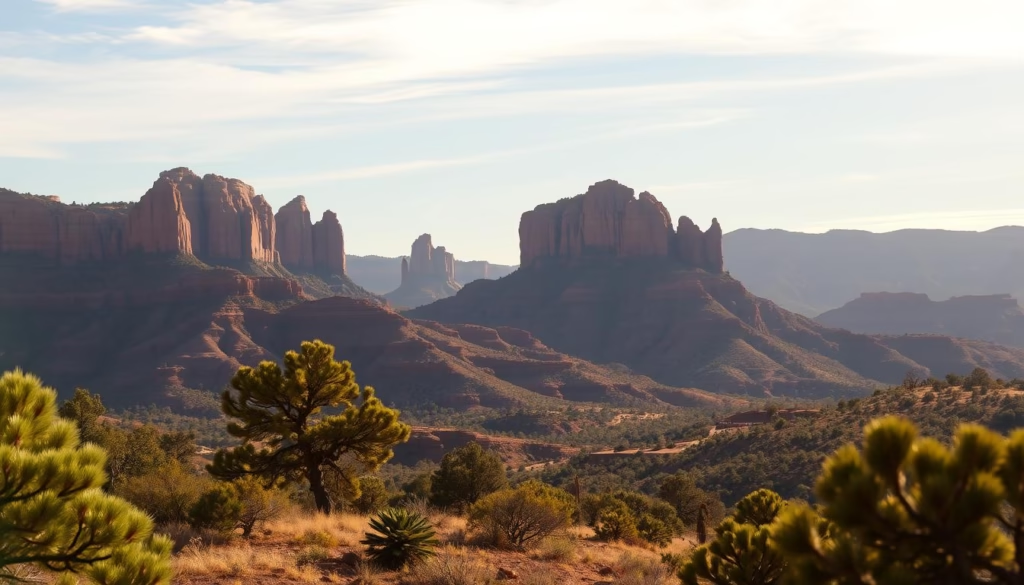
Scenic Hiking Trails and Vortex Spots
Devil’s Bridge Trail rewards hikers with natural stone arches framing panoramic views. Cathedral Rock’s steep path leads to one of Sedona’s four main energy vortexes – spots many believe amplify meditation and healing. Locals swear you’ll feel the difference:
“Time slows down here. The rocks hum with energy you can’t explain.”
| Trail | Difficulty | Unique Feature |
|---|---|---|
| Bell Rock Path | Easy | Vortex access |
| Boynton Canyon | Moderate | Ancient ruins |
| Bear Mountain | Challenging | 360° views |
Local Retreats and Wellness Escapes
Sedona’s spa scene blends Native traditions with modern therapies. Try a juniper-sage massage at a cliffside resort or sound baths using crystal singing bowls. Three signature experiences:
- Sunrise yoga at Airport Mesa
- Chakra-balancing sessions near Oak Creek
- Stargazing meditation tours
Art galleries dot Highway 179, showcasing landscapes that mirror the surrounding mountains. While luxury resorts command premium prices, nearby Cottonwood offers budget-friendly stays. Visit March-May or September-November for ideal weather and vivid desert blooms.
Saguaro National Park: Embracing Iconic Desert Landscapes
Standing like desert sentries, saguaro cacti guard Arizona’s most iconic wilderness. These slow-growing giants take 75 years to sprout their first arms, eventually reaching heights rivaling four-story buildings. Their wrinkled forms tell stories of survival in the desert landscape, where temperatures swing wildly between day and night.
Ancient Giants and Scenic Drives
The park splits into two distinct districts. Tucson Mountain District’s dense saguaro forests frame golden-hour photo ops, while Rincon Mountain District’s higher elevation reveals prehistoric petroglyphs. Both areas offer paved loops perfect for cycling or leisurely drives. Come April, white blossoms crown the saguaro cacti, attracting thirsty bats and bees.
November through March brings ideal hiking weather. Mornings cool enough for Bajada Loop Trail adventures, afternoons warm for picnics under palo verde trees. Rangers lead sunset tours explaining how these cacti store 200 gallons of water – a lifeline during arid months.
Smart visitors pack wide-brimmed hats for sun-drenched hours. Pair morning walks with afternoon museum stops showcasing Tohono O’odham cultural artifacts. Whether crafting half-day itineraries or weeklong explorations, this park proves deserts teem with life when you know where to look.
